It turns out that the braking of stars rotation would stop instead of continuing to slow down as we would expect. Which change in a star could explain such a stop of the deceleration?
Three studies to catch the "Sun in time"
In order to answer these key questions concerning our star, an international team, including researchers from Laboratory Dynamics of Stars, (Exo)-planets and their Environment/ The French Alternative Energies and Atomic Energy Commission (LDE3/CEA), has carried out three studies, based on observations and multidimensional magnetohydrodynamic High-Performance Computing (HPC) numerical simulations on GENCI supercomputers.
They studied the origin of the magnetism and rotation of the Sun and solar-type stars (via the physical mechanism known as fluid dynamo) in a "Sun in the time" approach.
After more than five years of code development and millions of hours of computation, these studies have highlighted the essential role of a parameter, called the "Rossby number", to characterize the internal rotation properties of stars and the nature of their magnetism over secular time.
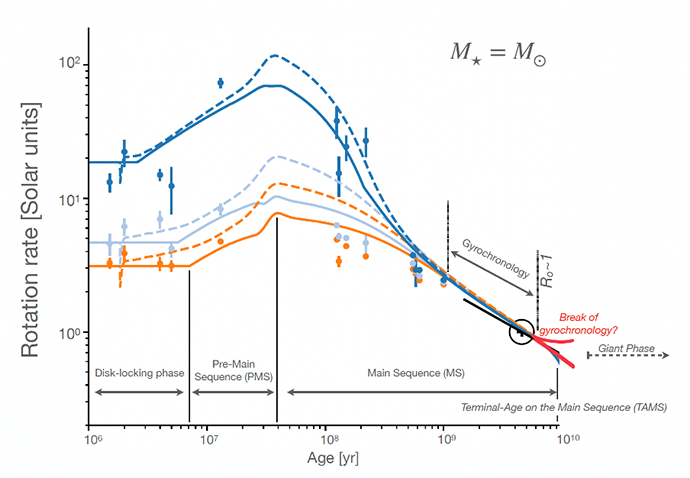
Rotational history of solar-type stars
In Figure 2 we can follow the evolution of its rotation.
- In it's young phase it first goes through a plateau, the rotation stays constant over several millions of years, as long as the star has not decoupled from its primordial disk of matter (or accretion disk).
- Once this disk has dissipated (for example by forming planets), the star then contracts and accelerates (pre-main sequence phase or PMS) to reach the highest rotational velocities, until the conditions in its nuclear core are sufficient to trigger the burning of hydrogen by nuclear reactions. This critical point in the evolution of our star is called the ZAMS (zero age main sequence).
- The Sun then enters its main sequence and its rotation slows down by loss of angular momentum through its magnetized wind of particles. In a similar way to the ice-skater spreading his arms to slow down the rotation of his pirouette, this magnetized wind will then generate a lever arm effect (a “torque”). The amplitude of this torque depends on the intensity and geometry of the magnetic field created, and will progressively decrease the rotation rate of the star. A faster rotation will tend to generate a more intense magnetic field, and thus a stronger braking by magnetized wind (dark blue curve). On the contrary, a weaker rotation will mainly generate less intense fields, and will therefore be impacted by weaker braking (orange curve).
This non-linear feedback loop "rotation -> dynamo -> magnetism -> wind -> braking -> rotation" makes stars with the same mass to spin down and converge toward a common rotational behavior, called the Skumanich's law.
It was proposed by Skumanich in 1972, then Barnes in 2003, that the slowing down of solar type stars, follows a law as Ω(t)∝t-1/2, i.e., they all converge toward the same rotation after reaching the age of the Hyades (about 650 to 800 million years). This direct relationship between age and rotation rate of solar-type stars has been called gyrochronology. Coming along with this evolution of the star's rotation rate over secular times, there is also a change in the level of magnetic activity.
Young stars rotate rapidly and are very active magnetically, older stars are slow and less active.
- However, the gyrochronology has recently been possibly questioned by the data of the Kepler satellite (Van Saders et al. 2016). The braking of solar-type stars would stop (red lines) slightly after the age of the Sun (about 4.5 Gyrs). This means that the wind would not be as efficient to extract the angular momentum of stars after this age.
We must therefore better characterize the complex feedback loop between dynamo -> magnetism -> wind -> braking -> rotation -> dynamo to understand the secular evolution of the magnetism of solar-type stars and the possible existence of magneto-rotational regime changes.
Different types of rotation profile and activity
It turns out that these changes of regime can be delimited with a quantity called
"Rossby number", named after the famous Swedish physicist, which allows to characterize how the rotation of a star influences its internal dynamics, in particular the convection.
Thanks to multidimensional numerical simulations carried out on GENCI’s supercomputers, a team of researchers from LDE3/CEA (France) with international colleagues has developed simulations of the dynamo of solar-type stars with this precise goal (results published in Brun et al. 2022).
By changing the mass and rotation, and thus the Rossby number Ro, of 15 simulated stars, they were able to explore different states of internal rotation of the star and consequently of its magnetism. These simulated stars are divided into three characteristic rotation states shown on Figure 3:
- Fast (young) rotators: A state of rotation with a profile which is strongly constrained by the joint action of Coriolis and Lorentz forces, bringing quasi-solid rotations (rotating in one bulk, like a snooker ball), for the lowest Ro < 0.2,
- Intermediate rotators: A so-called “solar-type” rotation state, with a fast equator and slow poles (intermediate ages), Ro ~ 0.2-0.7,
- Slow (old?) rotators: A state of rotation called “antisolar”, reversed with respect to the Sun, with fast poles and a slow equator (Ro > 1)
-
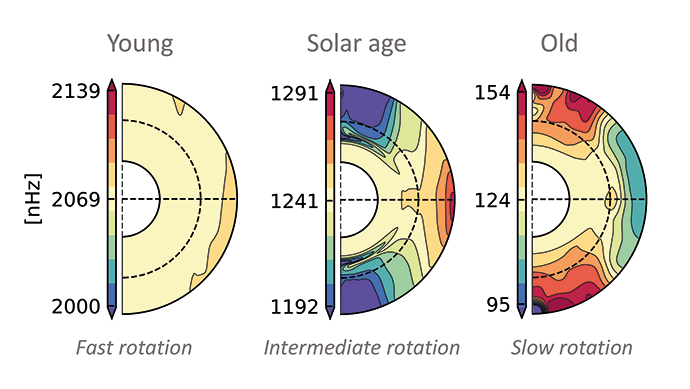
Figure 3: Rotation profiles in a meridional slice of three 3D convective dynamo simulations of a solar-type star at different rotation rates (Rossby numbers Ro, Ro < 0.2 (left), Ro ~0.3-0.7, Ro > 1 (right)). Adapted from Noraz et al. (2022b). This change of rotation profile results in a different behavior of the dynamo in the simulations, some presenting magnetic cycles while others do not.
-
Figure 4, shows a synthesis of the stellar magnetic state resulting, according to the Rossby number. We can notice 3 main classes:
- cyclic dynamos with short period (< 2 years) for small Rossby numbers (top figure), resulting from surface dynamo waves and generating local polarity reversals. The quasi-biennial oscillation (Simoniello et al. 2013) could be a remnant of this process,
- long decadal cycles for intermediate Rossby numbers (middle figure), i.e. similar to the Sun. Significant energy transfers at the base of the convection zone (up to several % of the solar luminosity) allow polarity reversals of the large-scale magnetic field in a prey/predator-type mechanism, creating torsional oscillations,
- and finally stationary dynamos for Rossby numbers greater than 1 (bottom), without cyclic activity.
It seems that for slow rotators (generally old stars), an antisolar rotation state leads to a transition of dynamo regime from cyclic to stationary.
-
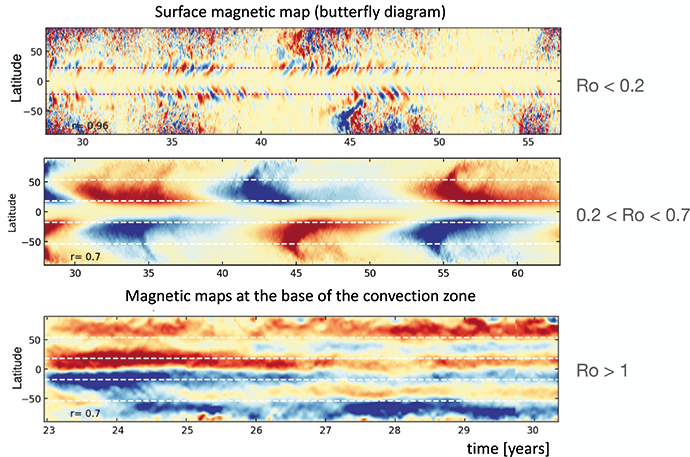
Figure 4: Butterfly diagrams” for the 3 classes of solar-type stars dynamos. This is a time-latitude representation of the poloidal (top) and toroidal (middle and bottom) magnetic field polarities. The red/blue color represents a positive/negative polarity. The case of the Sun corresponds to the middle panel. Adapted from Brun et al. (2022) In order to confirm this stationary dynamo state in the case of antisolar rotation, the team has undertaken a specific study of antisolar dynamos in Noraz et al. (2022a), using a reduced, but faster, 2-dimensional model in order to extend the parameter space covered (the 3D simulation being very costly in terms of computation time, it would make the systematic study of the parameter space much numerically costly and too long).
Part of this study is summarized in Figure 5, where different paths for the dynamo loop are illustrated. In most antisolar cases, the dynamo loop reinforces the field at the poles (top line), rather than cancelling it to change its polarity as in the solar case (bottom line). -
We recall that the sign of the global magnetic field of the Sun (dipolar) is reversed every 11 years on average. It seems therefore that slow rotators have a real probability of having a non-cyclic magnetism,
-
confirming previous results of the 3D study. Nevertheless, magnetic cycles can be produced by anti-solar DR for specific dynamo models. A detection of magnetic cycles for such stars (or lack of thereof) would therefore be a tremendous constraint on deciphering what type of dynamo is actually acting in the Sun and how it will evolve.
-
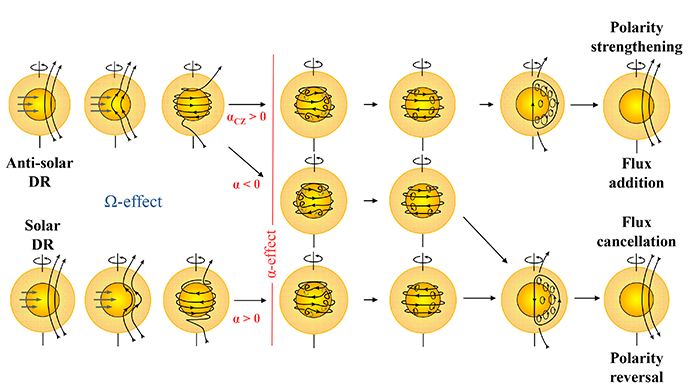
Figure 5: Different possible paths for a stellar dynamo. Bottom: Solar reference cases where global magnetic polarity is reversed at the end of the loop (AC dynamo). Top: anti-solar DR case where the Ω-shearing is reversed, while still considering a similar α parameterization. This leads to a stationary state without cycle (DC dynamo). Middle: anti-solar DR where α sign is reversed, thus considering the change in nature of convection happening at the base of the convection zone. This leads to a cyclic solution, like in the solar case. Adapted from Noraz et al. (2022a). For cases without activity cycles, does this mean that the large-scale magnetic geometry of the simulation has also changed? For example, from the domination of a large-scale dipole to a smaller-scale magnetic field structure, called multipolar? If this were the case, the efficiency of the braking by the magnetized wind torque would be strongly reduced once this transition happens. Indeed, the larger the magnetic field and the more intense it is, the more leverage it provides, like the wings of a windmill offering a large surface, to brake the star efficiently.
When the team of researchers studies the global magnetic geometry of the antisolar dynamos and compares it to the fast rotators, they do not notice any obvious change in the amplitude of the dipole (or of the other large-scale components of the magnetic field) that could lead to a stop of the rotation’s deceleration. Indeed, Figure 6 shows the amplitude of the dipole in the 15 simulations as a function of the Rossby number, compared to observations (black dotted line). As simulations of stars younger than the Sun (here for Ro < 1) reproduce well spectro-polarimetric observations as a function of the Rossby number, this comfort the authors that the simulations are robust and realistic.
On the other hand, when considering cases with Ro > 1, the amplitude does not follow the same trend, or even a more abrupt decrease of the dipole amplitude. On the contrary, there seems to be a possible rise of the large-scale magnetic field. The magnetic dipole of the slow rotators associated with their stationary dynamo (no cycle) is therefore not negligible, on the contrary it is even dominant.
-
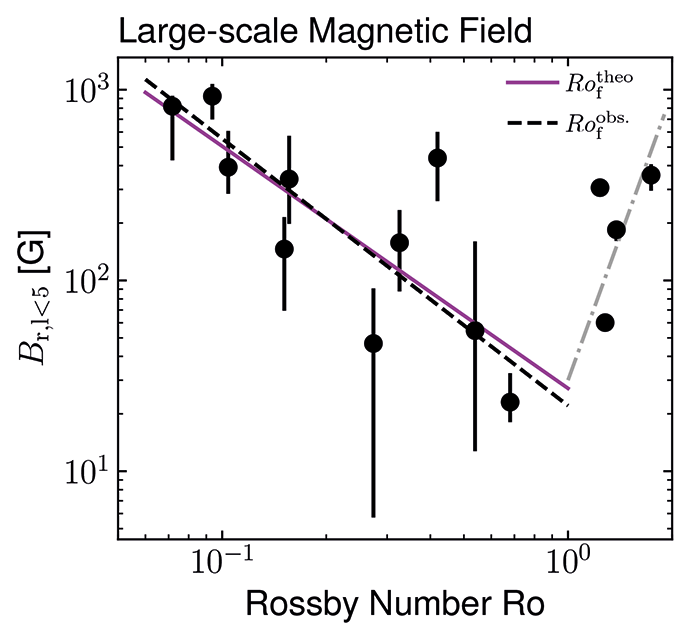
Figure 6: Amplitude of the large-scale magnetic field in the 15 simulations (small black circles with error bar) of stellar convective dynamo. Adapted from Brun et al. (2022). Therefore, it seems unlikely that a disappearance of the magnetic dipole would provoke the slowing down of the stars observed in the Kepler study cited above (Van Saders et al. 2016). On the other hand, it is interesting to note that Figure 6 shows the possible existence of a local minimum around the age of the Sun (around Ro~1). This raises the question of whether stars could get "stuck" there, thus explaining their inefficiency to slow down according to Skumanich's law. But once this minimum is passed, the stars would a priori find a more intense braking back. The duration of this "stalling" phase will thus depend on the shape of the minima, either U-shaped or V-shaped.
-
Looking for anti-solar rotating stars in observation catalogs
-
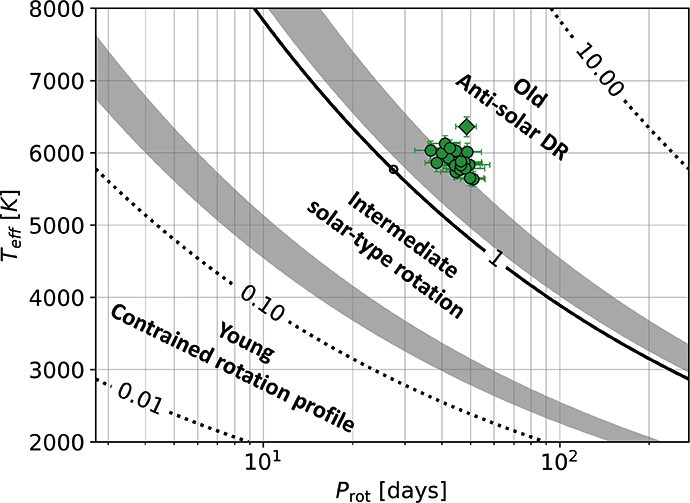
Figure 7: Surface (effective) temperature and rotation period (in days) plot, where the antisolar star candidates in Kepler observations are represented after filtering with our Rossby number diagnostic (from Noraz et al. 2022b). Adapted from Noraz et al. 2022b. Thereby, new observational constraints on high-Rossby stars, and possibly “anti-solar”, would appear to be a major asset to understand the possible magneto-rotational future of our Sun. Robust detection of anti-solar DR on the main-sequence is indeed still pending…
In this context, the research team has undertaken the identification in the Kepler satellite data of stellar candidates, whose rotation profile could be antisolar, in order to first confirm the existence of this profile (Noraz et al. 2022b). Among 200,000 stars in the catalogs consulted (Kepler...), only 55,000 of them had an estimate of their rotation. From this subsample, the researchers calculated their Rossby number and only found 22 of them with Ro>>1! Figure 7 represents the stars of the Kepler sample having a large observational Rossby number, likely to possess an antisolar rotation profile.
This magneto-rotational scenario of stars will guide in part the future PLATO space mission (ESA), from which future seismological observations will be considered to confirm and/or improve the predictions from 3D models. Indeed, mastering the origin of magnetism and its variability improves the detection of exoplanets, which is often disturbed by the activity of the host star. In that sense, the study of stellar magnetism allows to reconstruct their magneto-rotational history, and most especially the solar one, but can also help to better characterize the numerous exoplanets present in our close environment, and thus better constrain our knowledge on the possibilities of life within our galaxy.
-

One of the authors: Quentin Noraz, Postdoctoral Fellow at RoCS - Rosseland Centre for Solar Physics. References
-
Noraz Q., Breton S. N., Brun A. S., García R. A., Strugarek A., Santos A. R. G., Mathur S., Amard L., 2022, "Hunting for anti-solar differentially rotating stars using the Rossby number. An application to the Kepler field", A&A 667, A50
-
Brun A. S., Strugarek A., Noraz Q., Perri B., Varela J., Augustson K., Charbonneau P., Toomre J., 2022, "Powering Stellar Magnetism: Energy Transfers in Cyclic Dynamos of Sun-like Stars", ApJ, 926, 21
-
Noraz Q., Brun A. S., Strugarek A., Depambour G., 2022, "Impact of anti-solar differential rotation in mean-field solar-type dynamos. Exploring possible magnetic cycles in slowly rotating stars", A&A, 658, A144
-
Ahuir J., Strugarek A., Brun A.-S., Mathis S., 2021, "Magnetic and tidal migration of close-in planets. Influence of secular evolution on their population", A&A, 650, A126
-
Strugarek A., Beaudoin P., Charbonneau P., Brun A. S., do Nascimento J.-D., 2017, "Reconciling solar and stellar magnetic cycles with nonlinear dynamo simulations", Sci, 357, 185
-
van Saders J. L. , Ceillier T., Metcalfe T. S, Silva Aguirre, V., Pinsonneault M. H., García R. A., Mathur,S., Davies G. R., 2016, "Weakened magnetic braking as the origin of anomalously rapid rotation in old field stars" , 529
-
Simoniello R. , Jain K. , Tripathy S. C. , Turck-Chièze S. , Baldner C. , Finsterle W. , Hill F. , Roth M. , 2013, "The Quasi-biennial Periodicity as a Window on the Solar Magnetic Dynamo Configuration", 765
